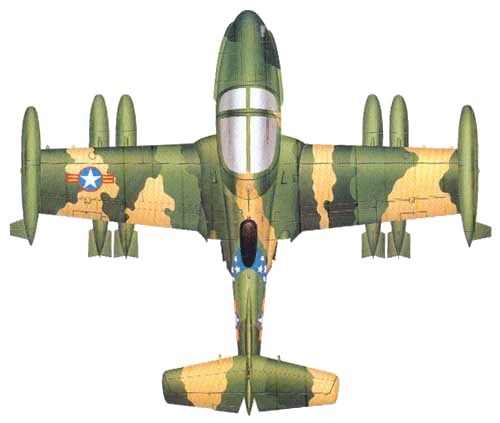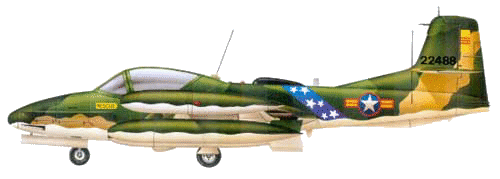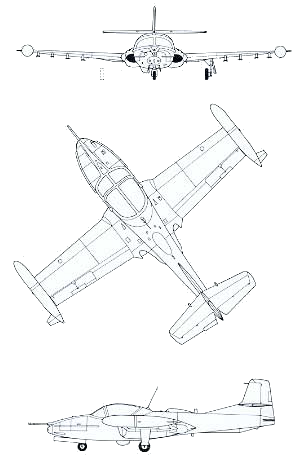|

Cessna A-37B Dragonfly
In the first part of the 1950s Cessna
went in for military production, designing the first jet trainer for the
USAF, the T-37. From this machine (of which 1,268 models of three basic
versions were built between 1955 and 1977), an efficient attack plane was
derived in 1963, the A-37, which was also successfully exported. The
prototype flew on October 22 and the first 39 A-37As were produced by
direct conversion of other T-37Bs. The definitive version was the A-37B,
which first appeared in September 1967 and of which 577 were built with
the majority of these going to the USAF.
One of the few aircraft designed from
the start for tactical support, the A-37 arrived in Vietnam toward the end
of the 1960s and was mainly used in support of helicopter operations.
Capable of mounting a wide range of weapons, it proved highly adaptable to
diverse operational needs. Particularly effective were its low-level
napalm bomb attacks. A fairly limited number of machines, under the
colours
of both the USAF and the VNAF (the illustration shows the VNAF insignia),
were used in action.
US Army
During the late 1950s the Army Aviation
Test Board and the Aviation Combat Developments Agency (ACDA) began to
jointly explore the feasibility of using Army-operated fixed-wing jet
aircraft in the artillery adjustment, tactical reconnaissance, and ground
attack roles. Operational necessity dictated that any such aircraft be
easy to maintain under field conditions and capable of operating from
unimproved forward air strips, and these prerequisites indicated that any
jet procured for Army use would have to be simple and relatively small,
yet at the same time be of robust construction and able to offer a
performance significantly better than that of the various piston-engined
machines then in Army service. Cessna's diminutive T-37 twin-engined
primary trainer admirably fulfilled all these requirements, and in early
1958 three examples borrowed from the Air Force were sent to Fort Rucker
to begin a one year Army evaluation programme dubbed Project LONG ARM.

US Army T-37
The Cessna Model 318 had been adopted by
the Air Force as the T-37 after winning a 1953 USAF-sponsored design
competition for a new primary jet trainer. The first of two prototype
XT-37s had made its maiden flight in early 1954, and the first eleven
production T-37As had entered USAF service in 1955. The three aircraft
evaluated by the Army were all -A model machines of the fourth production
batch, and carried the serial numbers 56-3464 to -3466. The T-37, widely
if unofficially known as the 'Tweetybird', was characterized by low-set,
non-swept wings, side-by-side crew seats, and a broad forward fuselage.
The type was equipped with ejection seats for both crewmen, and its
cockpit instruments and controls were identical to those found in
frontline USAF aircraft. The T-37A was powered by two Continental J69
turbojets, one buried in each wing root, and was quite manoeuvrable and
relatively easy to fly.
The Army's evaluation of the T-37 found
the aircraft to be ideally suited for Army use and both the Aviation Board
and the ACDA recommended quantity procurement of the type. However,
mounting Air Force opposition to Army ownership and operation of
fixed-wing jet aircraft eventually forced the Army to abandon the planned
T-37 acquisition and all three machines used in the Project LONG ARM tests
were returned to the Air Force in early 1959.




Technical Specifications
Aircraft:
Cessna A-37B
Year: 1967
Type: attack
Manufacturer: Cessna Aircraft Co.
Engine: 2 x General Electric J85-CE-17A
Power: 2,850 lb (1,293kg)
Wingspan: 35ft 10½ in (10.93m)
Length: 29ft 3in (8.92m)
Height: 8ft 10½ in (2.70m)
Wing area: 183.9sq ft (17.09m²)
Max take-off weight: 15,000 lb (6,804kg)
Empty weight: 5,873 lb (2,670kg)
Max speed: 478mph at 15,000ft (769km/h at 4,572m)
Service ceiling: 32,100ft (9,785m)
Range: 450mi (724km)
Crew: 2
Load-armament: 1x7.62mm minigun; 5,4001b (2,450kg)
|
